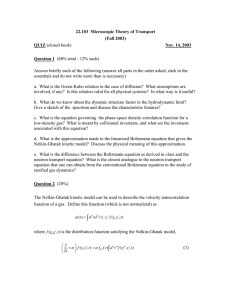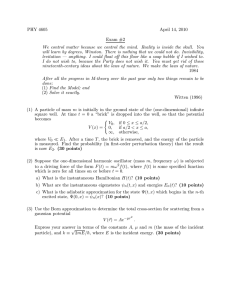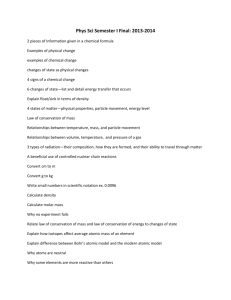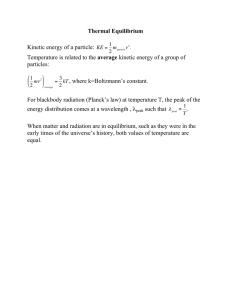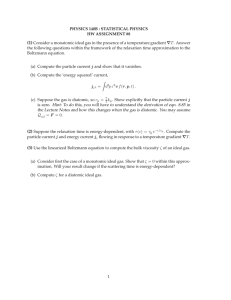conservation laws and the quantum theory of transport: the early days
advertisement
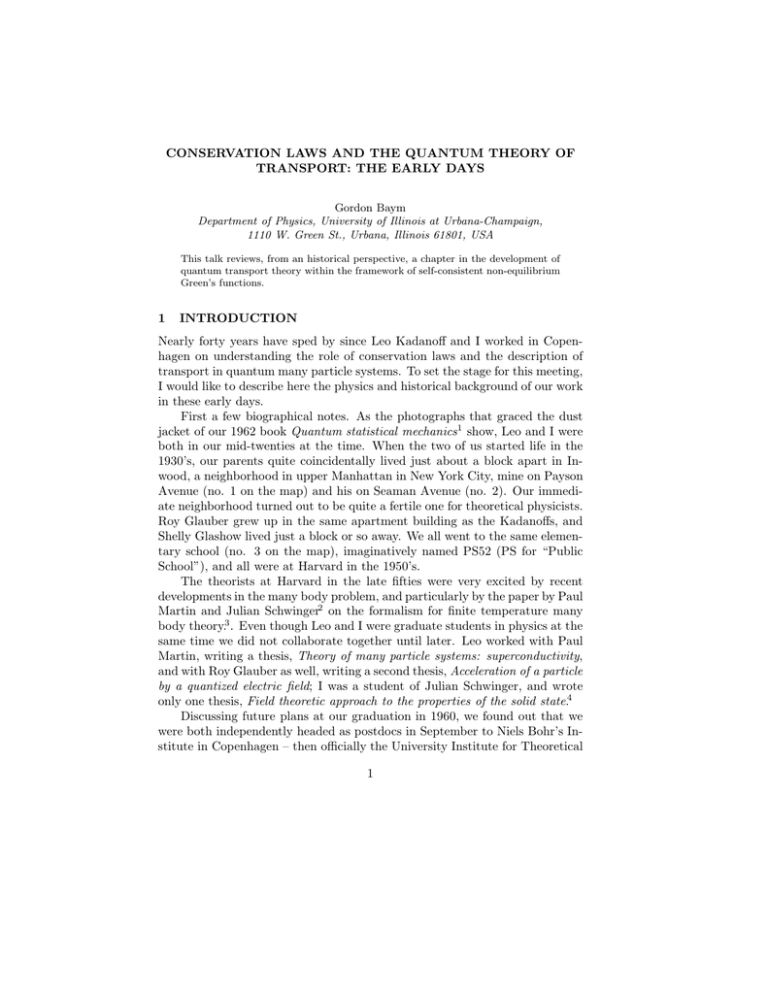
CONSERVATION LAWS AND THE QUANTUM THEORY OF TRANSPORT: THE EARLY DAYS Gordon Baym Department of Physics, University of Illinois at Urbana-Champaign, 1110 W. Green St., Urbana, Illinois 61801, USA This talk reviews, from an historical perspective, a chapter in the development of quantum transport theory within the framework of self-consistent non-equilibrium Green’s functions. 1 INTRODUCTION Nearly forty years have sped by since Leo Kadanoff and I worked in Copenhagen on understanding the role of conservation laws and the description of transport in quantum many particle systems. To set the stage for this meeting, I would like to describe here the physics and historical background of our work in these early days. First a few biographical notes. As the photographs that graced the dust jacket of our 1962 book Quantum statistical mechanics1 show, Leo and I were both in our mid-twenties at the time. When the two of us started life in the 1930’s, our parents quite coincidentally lived just about a block apart in Inwood, a neighborhood in upper Manhattan in New York City, mine on Payson Avenue (no. 1 on the map) and his on Seaman Avenue (no. 2). Our immediate neighborhood turned out to be quite a fertile one for theoretical physicists. Roy Glauber grew up in the same apartment building as the Kadanoffs, and Shelly Glashow lived just a block or so away. We all went to the same elementary school (no. 3 on the map), imaginatively named PS52 (PS for “Public School”), and all were at Harvard in the 1950’s. The theorists at Harvard in the late fifties were very excited by recent developments in the many body problem, and particularly by the paper by Paul Martin and Julian Schwinger2 on the formalism for finite temperature many body theory.3 . Even though Leo and I were graduate students in physics at the same time we did not collaborate together until later. Leo worked with Paul Martin, writing a thesis, Theory of many particle systems: superconductivity, and with Roy Glauber as well, writing a second thesis, Acceleration of a particle by a quantized electric field; I was a student of Julian Schwinger, and wrote only one thesis, Field theoretic approach to the properties of the solid state.4 Discussing future plans at our graduation in 1960, we found out that we were both independently headed as postdocs in September to Niels Bohr’s Institute in Copenhagen – then officially the University Institute for Theoretical 1 Figure 1: Leo Kadanoff (left) and Gordon Baym (right), circa 1961; from the dust jacket of Quantum Statistical Mechanics. Physics. Copenhagen, with far more bicycles than cars on the streets, was one of the foremost gathering places of physicists from around the world5 – a remarkable experience for two fresh Harvard Ph.D.’s. I stayed for two years, and Leo for a little over one year. 2 THE PUZZLES Since the main emphasis at the Institute at the time was nuclear physics and our focus was on condensed matter problems we had little mentoring from the senior people, with the important exception of Gerry Brown; primarily we worked on our own. Leo’s and my collaboration began one day in our first Spring in Copenhagen, when he raised the question of how to construct in the Martin-Schwinger Green’s function formalism approximations to the two particle propagators that preserved the simple conservation laws. For example, the operator number conservation law, ∂ρ(rt) + ∇ · j(rt) = 0, ∂t (1) implies that correlation functions of the density and current with an arbitrary operator, O(r t ), should obey ∂ T (ρ(rt)O(r t )) + ∇ · T (j(rt)O(r t )) ∂t = [ρ(rt), O(r t)])δ(t − t ). 2 (2) Hu ds on R ive r The Bronx River Inwood 2 Ha r le m 1 3 St. an ckm Dy 20 7 th Bro adw ay St. Manhattan 500 m Figure 2: The Inwood area of upper Manhattan. where T denotes time-ordering of the operators. Leo’s interest in the problem arose from the question of how to write the BCS theory of superconductivity in a way that would yield correctly the Anderson mode – the longitudinal collective oscillation of a neutral superconductor6 (now famous in high energy physics as the Higgs boson). As originally formulated the BCS theory did not give two-particle correlation functions that obeyed the number conservation condition (2). Equivalently, the problem was how to build local gauge invariance into the theory. The more general issue was how to construct, within the Green’s function formalism, consistent quantum theories of transport. This problem was nagging me too, because, as Paul Martin pointed out at my doctoral defense, I had essentially gotten it wrong in my thesis. In trying to calculate sound wave damping in a metal via simple 3 Green’s function approximations, I was missing a factor of 4/5 compared with a calculation via the Boltzmann equation. Paul immediately realized that the lack of this factor indicated a conceptual error in the underlying physics. It is very hard to get a factor of five from simple mistakes – in this case it comes from P2 (cos θ)2 , which arises from correctly including the scattering backinto-the-beam term in the transport equation. Leo’s and my problems were closely related. x x' (a) (b) (c) Figure 3: (a) The one loop approximation, (b) the self-energy corrections on the lines that are included, and (c) scattering into-the-beam corrections. To see how approximations can fail obey to the conservation laws consider going beyond the lowest order evaluation of the density-density and currentdensity correlation functions in the Hartree-Fock approximation, i.e., as a single loop of Green’s functions. The lowest order calculation, Fig. 3a, in which the lines are Hartree-Fock Green’s functions, obeys the conservation laws. The trouble starts when one tries to improve the Green’s functions beyond lowest order, including better self-energies, as shown in Fig. 3b, but not vertex corrections. In the one loop approximation, the density-density correlation function, in imaginary time, is given (in the notation of Ref. 1) by d3 p d3 p G(p, zν )G(p , zν ) T (ρ(rt)ρ(r t )) = ∓T 2 3 3 (2π) (2π) νν ×ei(p−p )·( r− r ) −i(zν −zν )(t−t ) e . (3) The current-density correlation function is similarly d3 p d3 p p + p G(p, zν )G(p , zν ) T j(rt)ρ(r t ) = ∓T 2 3 3 2m (2π) (2π) νν ×ei(p−p )·( r− r ) −i(zν −zν )(t−t ) e . (4) Trying to see if the correlation functions obey the number conservation law, 4 Eq. (1), we find, using Dyson’s equation for the Green’s functions, G−1 (p, z) = z − that p2 + Σ(p, z), 2m (5) ∂ T (ρ(rt)ρ(r t )) + ∇ · T j(rt)ρ(r t ) ∂t d3 p d3 p = ±iT 2 (Σ(p, zν ) − Σ(p , zν )G(p, zν )G(p , zν ) 3 3 (2π) (2π) νν ×ei(p−p )·( r− r ) −i(zν −zν )(t−t ) e . (6) The right side, which involves the difference of the self-energies, does not vanish in general beyond the Hartree-Fock approximation. Even with a constant particle lifetime, τ , corresponding to scattering by random impurities, the correlation functions fail to obey the conservation laws. For a constant lifetime the spectral function of G is A(p, ω) = 1/τ (ω − p2 /2m)2 + 1/4τ 2 , (7) with the corresponding self-energy given by Σ(z) = ±i/2τ (where the + sign is for the complex frequency z in the upper half plane, and the - sign for z in the lower half plane). In order to include the conservation laws correctly it is necessary to include the scatterings between the two lines, as shown in Fig. 3c; these correspond to including the scattering back-into-the-beam terms in the Boltzmann equation. The subtle feature of the problem of the correlation functions obeying the conservation laws was that it was not sufficient merely to include particle number and momentum conservation at the individual vertices in a diagrammatic expansion. Simple approximations to the correlation functions need not obey the conservations laws, even though particle number and momentum are conserved at the individual vertices. The second piece of the puzzle of constructing a quantum theory of transport phenomena was that it required summation of an infinite set of diagrams. Let me illustrate the point by means of the simple example of the electrical conductivity of a metal. Consider first the trivial example of classical carriers of charge e moving at velocity v in the presence of an electrical field E(t) and a friction force described by a scattering time τ . Newton’s equation reads m dv − m v ; = eE(t) dt τ 5 (8) for an electric field of frequency ω, the velocity is, v (ω) = e E(ω) . m −iω + 1/τ (9) one finds the complex Since the electrical current produced is j = nev = σ E, conductivity, σ(ω) = τ ne2 , m 1 − iωτ (10) Re(σ) = ne2 τ , m 1 + ω2τ 2 (11) whose real part, determines the dissipation. In the collisionless regime, ωτ 1, Re(σ) ∝ τ −1 , i.e., proportional to the scattering rate, or scattering matrix elements, Mpp , squared. This result follows directly from perturbation theory. On the other hand, in the collision-dominated regime, ωτ 1, the dissipation Re(σ) ∝ τ , is inversely proportional to the matrix elements squared, a very difficult result to derive by summing diagrams in perturbation theory. The standard derivation of the conductivity in terms of scattering matrix elements is via the Boltzmann equation, which for electrons scattering on impurities reads, ∂fp · ∇p fp + vp · ∇r fp − eE ∂t d3 p =− 2π|Mpp |2 δ(p − p )[fp (1 − fp ) − fp (1 − fp )]. (2π)3 (12) Linearizing the distribution function in the form fp = fp0 +∇p fp0 ·u, one readily finds from Eq. (12) that u = eE τtr , 1 − ωτtr (13) and σ= τtr ne2 , m 1 − iωτtr as in Eq. (10). Here the transport scattering time is given by d3 p 1 =− 2π|Mpp |2 δ(p − p )(1 − cos θ pp ). τtr (2π)3 6 (14) (15) The cos θ pp term is a result of the scattering back into the beam, described by the final fp (1 − fp ) collision term on right side of Eq. (12). The conductivity is given more generally in terms of the current-current correlation function, jj(z) (e.g., the Fourier transform of the retarded commutator) by σ(ω) = n i jj(ω + iη) + . ω m (16) To derive the low frequency limit from a diagrammatic expansion of the correlation function in terms of Green’s functions, one must sum an infinite set of diagrams, and to find the correct transport coefficients, include the scattering back-into-the-beam terms corresponding to Fig. 3c. The Boltzmann equation carries out such a summation brilliantly. The failure of approximate correlation functions to include the conservation laws meant that one could not correctly describe low frequency long wavelength transport phenomena, so well accounted for by the Boltzmann equation. The challenges facing us in building theories of quantum transport were thus to learn how to include the conservation laws in approximations to the correlation functions, and how, from Green’s functions, to recover and generalize the basic structure of the Boltzmann equation. 3 SELF-CONSISTENT APPROXIMATIONS Furiously scribbling all evening after Leo posed his question, I began to see how to include the conservation laws in two point correlations functions in terms of self-consistent approximations. The starting point was to include in imaginary time, from 0 to −iβ, an external potential coupled, e.g., to the density: (17) Hext (t) = d3 rρ(rt)U (rt). The single particle Green’s function then takes the form, tr e−β(H−µN ) T e−i dtHext ψ(1)ψ † (2) G(12; U ) = −i tr e−β(H−µN )T e−i dtHext (18) where T defines the time ordering along the imaginary time path, and the time integrals are from 0 to −iβ. The next step was to choose an approximation for the two particle Green’s function G2 (U ) in [0, −iβ], e.g., the Hartree-Fock approximation illustrated in Fig. 4a. From this G2 we constructed the single 7 G G ± G G (a) ± (b) 1 2 1' 2' (c) Figure 4: The procedure for deriving conserving approximations for the two particle correlation functions. Illustrated here for the Hartree-Fock approximation, in (a) one chooses an initial approximation to the two particle Green’s function, in (b) constructs the single particle self-energy from it, and in (c) constructs the conserving two particlel correlation function by differentiating the self-consistent one particle Green’s function. particle self-energy Σ, as shown in Fig. 4b in Hartree-Fock. The single particle Green’s function, G(U ), obeys Dyson’s equation (5) self-consistently. The key step now was to generate the two particle correlation function as a variational derivative of G(U ), via δG(1, 1 ; U ) = ±[G2 (12, 1 2+ ) − G(11 )G(22+ )]U=0 δU (2) U=0 ≡ ±L(12, 12+ ). (19) Figure 4c shows the resulting correlation function generated from the initial Hartree-Fock approximation, the random phase approximation with a sum of particle-hole ladders across the bubbles. For any starting approximation to G2 , the two particle correlation function generated as a variational derivative 8 obeys the differential conservation laws.7 Leo and I immediately wrote up our first and only journal paper together, Conservation laws and correlation functions.8 In preparing for this talk, I scoured through old notes in Urbana, and came upon the original typewritten draft of the paper, which contains both Leo’s and my handwriting, titled, Conservation laws and the quantum theory of transport. Recognizing his pivotal role in the development we listed Paul Martin as a prospective author, but he modestly declined to be on the masthead. His name is crossed out in the draft, and he is finally acknowledged for discussions that established the form of the conservation laws obeyed by the two particle correlation functions. We recognize in the draft that the self-consistent approximations for the two particle correlation functions yield linearized Boltzmann equations. After discussing the self-consistent T -matrix approximation for the self-energy of the single particle Green’s function G, we note that, “In the long wavelength limit the L equation leads to a generalization of the linearized Boltzmann equation in which the scattering cross section is proportional to |T |2 . This generalization reduces in turn to an ordinary Boltzmann equation in the low density limit. Thus our procedure enables us to derive the linearized Boltzmann equation from an equation which defines G(U ) from a sum of ladder diagrams.” Similarly, we mention deriving a Boltzmann equation from the shielded potential approximation, and finally, we promise that “the derivation of the generalized Boltzmann equations will be given in future publications.” The published paper strangely contains no mention of the Boltzmann equation. We did return, however, to Boltzmann equations in our book. At Gerry Brown’s instigation, we gave a series of lectures on the quantum many body problem in Copenhagen, and then to Ivar Waller’s group in Uppsala in the Spring of 1961, and in following Fall to WiesOlaw Czyż’s group in Krakow and at the Institute for Nuclear Studies at Hoża 69 in Warsaw. These lectures became the basis for our book. Writing the book was great fun; either we would sit together and write from scratch – actually Leo paced up and down non-stop, while I sat putting pen to paper – or often Leo would come in, in the morning, with the draft of a new chapter, which we would then revise. The whole bookwriting took, it seemed, less than a month. I recall the conversation with Leo about the order of authors names on the book. Since on our first paper, my name, being earlier in the alphabet than his, came first, he suggested that it would be fair if we alternated our names on subsequent publications; thus the book became Kadanoff-Baym. 9 Im t 0 Re t -i (a) - - -i (b) - - -i (c) Figure 5: The succession of contours in deriving generalized Boltzmann equations, from (a) the usual contour in imaginary time, shifted to −∞ in (b), and distorted to (c), the real time round-trip. 3.1 Generalized Boltzmann equations A good part of the book is devoted to deriving generalized Boltzmann equations from self-consistent approximations for the Green’s functions, a procedure for which Leo deserves full credit. The method begins with the Green’s function in the presence of an external potential, Eq. (18) on [0, −iβ], Fig. 5a, as we studied in Ref. 7. The contour of integration is then shifted back to [−∞, −∞ − iβ], as shown in Fig. 5b, and then distorted to the “round-trip” contour from −∞ to +∞ and back again to −∞ to −∞ − iβ. The Green’s function is given on 10 the round-trip contour by, tr e−β(H−µN ) T e−i dtHext ψ(1)ψ † (2) G(12; U ) = −i tr e−β(H−µN )T e−i dtHext (20) where now T defines the time ordering along the round-trip path, as shown in Fig. 5c, imaginary time path, and the time integrals are along the path. The external potential need not be the same on the two sectors of the contour along the real axis. The Green’s function on the path obeys, ∂ ∇2 i + − U (rt) G(rt, r t ) − Σ(rt, r̄ t̄)G(r̄ t̄, r t ) = δ(r − r )δ(t − t ). ∂t 2m (21) To derive the generalized non-linear Boltzmann equation, we write the distribution function in the Wigner form, g < (pωRT ) = drdte−ip·r+iωt ψ † (1 )ψ(1) (22) where r = r1 −r1 , t = t1 −tt and R = (r1 +r1 )/2, T = (t1 +t1 )/2. A new feature here was to treat the energy of the particles, ω, as a variable independent of their momentum p, thus allowing one to go beyond situations with well-defined quasiparticles. Expansion of the single particle Green’s function equations on the path for disturbances slowly varying in both space and time, yields the generalized Boltzmann equation, on which we are focussing at this meeting, p ∂g < ∂g < + (U + ReΣ) + · ∇R g < − ∇R (U + ReΣ) · ∇p g < ∂t ∂ω m ∂Re g ∂Σ< ∂Re g ∂Σ< − + ∇p Re g · ∇R Σ< − ∇R Re g · ∇p Σ< + ∂ω ∂t ∂t ∂ω = −Σ> g < + Σ> g < . (23) Here dω (g > + g < )(pωRT ) 2π z−ω 1 . = z − p2 /2m − U (RT ) − Σ(pzRT ) g(pzRT ) = (24) Understanding how to derive general Boltzmann equations from the many body formalism put the development of quantum transport theory on a firm 11 foundation. As we wrote, “Our rather elaborate Green’s function arguments . . . provide a means of describing transport phenomena in a self-contained way, starting from a dynamical approximation, i.e., an approximation for G2 (U ) in terms of G(U ). These calculations require no extra assumptions. The existence of local thermodynamic equilibrium is derived from the Green’s function approximations. The various quantities that appear in the conservation laws are determined by the approximation. The theory provides at the same time a description of what transport processes occur . . . and a determination of the numerical qantitites that appear in the transport equations.”9 Finally, we could derive the sound velocity of a gas from the Schrödinger equation. 3.2 Round-trip Green’s functions A crucial ingredient in the derivation of Boltzmann equations was the use of Green’s functions defined on the round-trip contour along the real axis. The method was invented by Schwinger, and presented in his lectures on Brownian motion at the Brandeis summer school in 1960, where I became familiar with it. Although the lectures were unpublished, Schwinger did write up the ideas in his paper Brownian motion of a quantum oscillator.10 As was always characteristic of Schwinger, not a diagram appears in the paper. Feynman put it well in his Talk at the First Schwinger Festspiel at the banquet for Schwinger on his sixtieth birthday in 1978, reminiscing about their conversation at the 1948 Pocono conference: “He [Schwinger] would say, well I got a creation and then another annihilation of the same photon and then the potential goes . . . I’d draw a picture that looks like this. He didn’t understand my pictures and I didn’t understand his operators, but the terms corresponded and by looking at the equations we could tell . . . that we had both come to the same mountain . . . .”11 The round-trip technique was also employed in the context of quantum electrodynamics in 1961-62 by Kalyana T. Mahanthappa, a fellow Schwinger graduate student at Harvard, and Pradip Bakshi, a slightly later student of Schwinger’s.12,13 Actually, Robert Mills (of Yang-Mills), while at the University of Birmingham in 1962, wrote but did not publish, a lovely set of notes on round-trip Green’s function techniques,14 which formed the basis for his later book.15 He refers in these notes to Schwinger’s 1961 paper, and remarks that, “The present work, some of which has, I believe, been duplicated independently by Baym and Kadanoff, following the methods of Martin and Schwinger, makes use of the thermodynamic Wick’s theorem of Matsubara and Thouless, and others, with the integration contour in the complex time plane distorted to include the real axis.” The method was then used by Leonid Keldysh in the 12 Soviet Union, described first in his 1964 paper.16 Our book was translated into Russian in the same year17 but Keldysh did not refer to it, writing rather, “Our diagram technique wlll be close to Mills’ technique for equilibrium systems,” citing Mills’ notes. Schwinger influence was widely felt. = 1 2 ± 1 2 = = ± (a) = n 1 n = = (b) = n 1 n = = (c) Figure 6: Φ and the corresponding self-energies Σ for (a) the self-consistent Hartree-Fock approximation, (b) the self-consistent T-matrix approximation, (c) the shielded potential approximation. 3.3 Φ-derivable approximations Leo left Copenhagen in late 1961 to accept an Assistant Professorship at the University of Illinois in Urbana, then one of the few centers of activity in many body physics. I was offered the same irresistible position at Illinois shortly after Leo arrived, but stayed in Copenhagen until September 1962 and then spent a year at Berkeley before going to the midwest. The problem that intrigued me in Copenhagen was how to delineate the structure of approximations to multiparticle Green’s functions that would include the conservation laws.18 The key turned out to be to start with a functional Φ[G] of the fully self-consistent Green’s function, G, from which one generates the self-energy self-consistently 13 as a variational derivative of Φ with respect to G: δΦ[G] = tr ΣδG. (25) The Green’s function, G, then self-consistently obeys Dyson’s equation with the self-energy, Σ, given by Eq. (25). The procedure is illustrated in Fig. 6, which shows Φ and the corresponding self-energies for the self-consistent Hartree-Fock, T-matrix, and shielded potential approximations. All correlations derived as variational derivatives then obey the conservation laws. The method made clear the relations between the conservation laws at the vertices and the macroscopic conservation laws. An extra bonus of this procedure was that various methods of calculating the thermodynamics from the selfconsistent G, e.g., coupling constant integration, all lead to the same result for the partition function,19 ln Z = ±[Φ[G] − tr ΣG + tr log(−G)]. (26) In the early 1960’s we could only apply the transport theory to a limited number of essentially exactly soluble problems, e.g., systems near local thermodynamic equilibrium, and the Landau theory of the normal Fermi liquid. The present explosion in computing power now offers the possibility of solving selfconsistent approximations numerically, as in the GW method in solids based on the shielded-potential approximation.20,21 Extensions of the approach to systems with condensates,22−24 and to relativistic systems, including electrodynamic and quark-gluon plasmas, both in equilibrium and non-equilibrium,25−27 open new windows to deal with systems of current experimental interest such as Bose condensed atomic clouds and ultrarelativistic heavy-ion collisions. As we see from the entirety of papers at this conference, we are standing on the threshold of a much deeper understanding of transport and equilibrium phenomena in a wide variety of interacting systems. Acknowledgements I would first like to express my gratitude to Michael Bonitz for organizing this meeting. His extraordinary efforts have given us a wonderful opportunity to learn about the recent progress made in harvesting the fruits of the little seedlings planted many years ago. I would also like to thank Michael Baym for preparing the graphics. It is a pleasure to acknowledge support by the U.S. National Science Foundation, from my early years in Copenhagen as a National Science Foundation Postdoctoral Fellow, through to current Grant No. PHY98-00978. 14 References 1. L.P. Kadanoff and G. Baym, Quantum Statistical Mechanics (W.A. Benjamin, New York, 1962). 2. P.C. Martin and J. Schwinger, Phys. Rev. 115, 1342 (1959). 3. Paul Martin, in his accompanying talk at this meeting, paints a vivid picture of the theoretical physics milieu at Harvard revolving around Schwinger in this era. 4. G. Baym, Harvard University (1960), unpublished. Annals of Phys. (N.Y.) 14, l (1961). 5. A charming history of the beginning of Niels Bohr’s Institute is P. Robinson, The Early Years; the Niels Bohr Institute 1921-1930 (Akademisk Forlag, Copenhagen, 1979). 6. P.W. Anderson, Phys. Rev. 112, 1900 (1958). 7. The variational derivative technique, which turned into a powerful tool in the many body problem, was originated by Schwinger in his papers on quantum field theory in Proc. Nat. Acad. Sci. 37, 379, 382 (1951). See Paul Martin’s talk in this volume for further discussion of these remarkable papers. I learned how to apply the technique from the unpublished Lecture notes on quantum field theory (Naval Research Laboratory, 1955) by Richard Arnowitt, an earlier student of Schwinger’s. 8. G. Baym and L.P. Kadanoff, Phys. Rev. 124, 287 (1961). 9. Ref. 1, p. 138. 10. J. Schwinger, J. Math. Phys. 2, 407 (1961). 11. R. P. Feynman, Themes in Contemporary Physics II, Essays in honor of Julian Schwinger’s 70 th birthday, S. Deser and R. J. Finkelstein, eds. (World Scientific, Singapore, 1989) pp. 92-93. 12. K. T. Mahanthappa, Phys. Rev. 126, 329 (1962). 13. P. M. Bakshi and K. T. Mahanthappa, J. Math. Phys. 4, 1, 12 (1963). 14. R. Mills, Progapators for quantum statistical physics, unpublished, 1962. 15. R. Mills, Propagators for many-particle systems, 1969. 16. L. Keldysh, Zh. Eksp. Teor. Fiz. 47, 1515 (1964) [Engl. tranl., Sov. Phys. JETP 20, 1018 (1965)]. 17. L.P. Kadanoff and G. Baym, Kvantovaya Statisticheskaya Mechanika (Izdatelstvo “Mir,” Moscow, 1964). The Russian edition was published at the munificent price of 77 kopecks. In late 1964 Leo brought back to Urbana the 500 rubles in royalties we were given for the translation – in the form of caviar; the ensuing party was quite memorable. 18. G. Baym, Phys. Rev. 127, 1391 (1962). 19. This relation between the partition function and the functional Φ was 15 20. 21. 22. 23. 24. 25. 26. 27. first derived for the exact theory by J. M. Luttinger and J. C. Ward, Phys. Rev. 118:1417 (1960). Reviewed in W.G. Aulbur, L. Jönsson, and J.W. Wilkins, Solid State Phys. 54, 1 (1999). C.-O. Almbladh, talk at this meeting; C.-O. Almbladh, U. von Barth, and R. van Leeuwen, J. Mod. Phys. B, vol. 13, p. 535 (1999). W. Götze and H. Wagner, Physica 31, 475 (1965). G. Baym and G. Grinstein, Phys. Rev. Dl5:2897 (1977). A. Griffin, Phys. Rev. B53, 9341 (1996); M. Imamović-Tomasović and A. Griffin, this volume. B. Vanderheyden and G. Baym, J. Stat. Phys. 93, 843 (1998); and this volume. Y. B. Ivanov, J. Knoll, and D. N. Voskresensky, this volume. J.-P. Blaizot and E. Iancu, Nucl. Phys. B557, 183 (1999). 16

